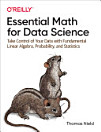Linear Mathematical Models In Chemical Engineering (Second Edition)
Martin Aksel Hjortso · Peter R Wolenski
ก.ค. 2018 · World Scientific
eBook
640
หน้า
family_home
มีสิทธิ์
info
reportคะแนนและรีวิวไม่ได้รับการตรวจสอบยืนยัน ดูข้อมูลเพิ่มเติม
เกี่ยวกับ eBook เล่มนี้
Mathematics remains a core area of engineering. Formulating and analyzing mathematical models of basic engineering systems is an essential skill that all engineering students should endeavor to acquire.This book will serve as an excellent introduction to linear mathematics for engineering students, both seniors and graduate students. It is the result of a collaboration between a chemical engineer and a mathematician, both of whom have taught classes on modelling and applied mathematics. It provides a broad collection of chemical engineering modelling examples to train students in model formulation and model simplification as well as give a thorough coverage of the mathematical tools used to analyze and solve linear chemical engineering models.Solution manual is provided for free to instructors who adopt this textbook. Please send your request to [email protected].
ให้คะแนน eBook นี้
แสดงความเห็นของคุณให้เรารับรู้
ข้อมูลในการอ่าน
สมาร์ทโฟนและแท็บเล็ต
ติดตั้งแอป Google Play Books สำหรับ Android และ iPad/iPhone แอปจะซิงค์โดยอัตโนมัติกับบัญชีของคุณ และช่วยให้คุณอ่านแบบออนไลน์หรือออฟไลน์ได้ทุกที่
แล็ปท็อปและคอมพิวเตอร์
คุณฟังหนังสือเสียงที่ซื้อจาก Google Play โดยใช้เว็บเบราว์เซอร์ในคอมพิวเตอร์ได้
eReader และอุปกรณ์อื่นๆ
หากต้องการอ่านบนอุปกรณ์ e-ink เช่น Kobo eReader คุณจะต้องดาวน์โหลดและโอนไฟล์ไปยังอุปกรณ์ของคุณ โปรดทำตามวิธีการอย่างละเอียดในศูนย์ช่วยเหลือเพื่อโอนไฟล์ไปยัง eReader ที่รองรับ





